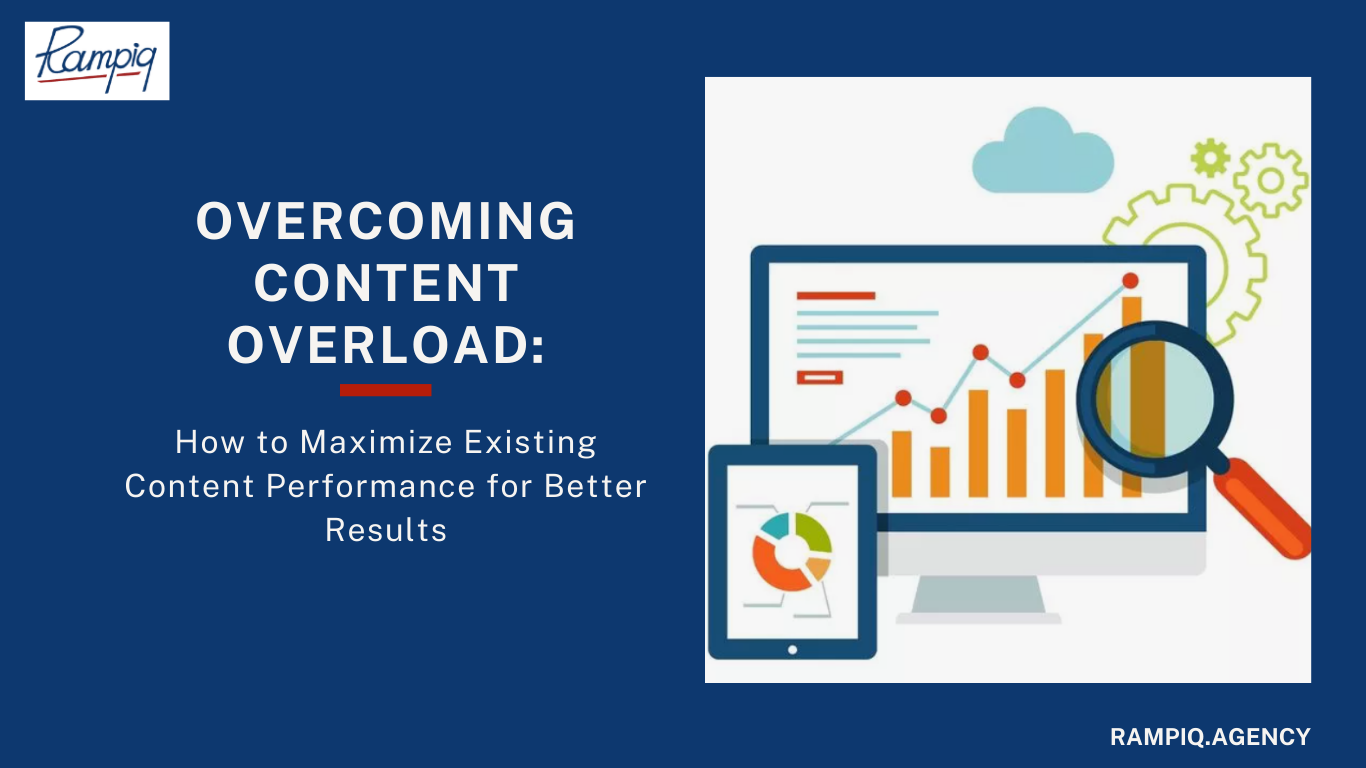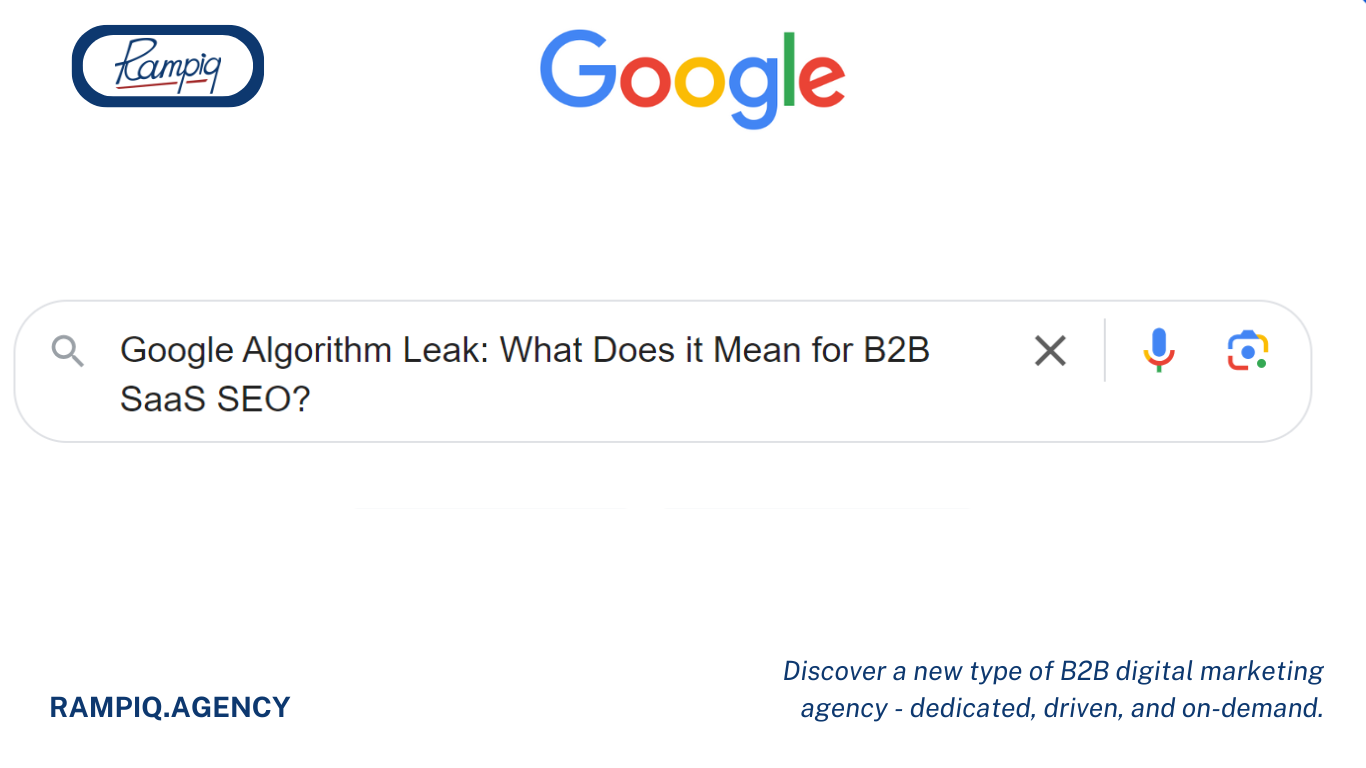What Is Dark Social?
Dark social is a type of website traffic that comes from users visiting through privately shared links and content. It’s also known as dark social media or dark traffic. The term “dark” refers to the fact that this type of traffic is very challenging to track and attribute to the origin of these users in lead generation.
For example, User A reads an article on your website that they found organically through a Google search. Then User A copies the page URL from the search bar and shares it with User B via a messaging app. User B follows the URL that they received in a direct message from User A and also reads the article. Analytics tools such as Google Analytics or alternatives will correctly attribute User A as a visitor coming from an organic search. But it will not entirely correctly deem User B as a visitor coming from direct traffic, since they actually came following a social interaction.
Dark funnel is a notion closely associated with dark social. It describes all hidden touchpoints with your business that a lead has before converting. Your CRM and analytics tools can track interactions such as website visits, whitepaper downloads, or calls with your sales team. But knowing the number of times the prospect talked about your company with colleagues or how many links to your website they shared with others is impossible.
Dark Social Examples
Dark social traffic typically comes from several sources, the most common being
- Private messaging apps
- Emails
- Social networks
- Corporate communications
- Word of mouth
Next, we’ll elaborate on these sources and how they generate users in dark traffic.
Private Messaging Apps
Users of WhatsApp, Facebook Messenger, Telegram, and other messaging apps share millions of website links every day. It’s typically done by copying the URL from the browser search bar and pasting it into the chat.
As a result, the URL that a user receives and then follows doesn’t contain any tracking tags. This website visit will be then attributed to direct traffic by the analytics tool.
Emails
People also share links and content via emails, and such a type of dark social can have more weight than DMs. When someone gets an email specifically dedicated to your company website, they are likely to treat it more seriously than a simple text message.
Social Networks
If anyone shares a link to your page in a Twitter post recommending your product or article, people that follow the link will also be considered dark social. The same logic applies to links shared in groups and communities on platforms like Facebook.
Corporate Communications
Links and content are also often shared in working environments between colleagues via tools like Slack. This type of dark social is arguably the most converting. Business decisions such as choosing a SaaS vendor are made during corporate communications and this kind of traffic tends to have the strongest intent.
Word Of Mouth
People often exchange opinions and give recommendations in face-to-face conversations. At a business event, someone might share their positive experience of using this or that SaaS at work, which can raise interest in their peers.
How Do You Track And Measure Dark Social?
Measuring dark social is possible with the help of analytics tools such as Google Analytics, customized contact forms and special dark social tracking software. Due to the vague nature of dark social, it must be said that none of these methods are 100% reliable. However, you’re strongly recommended to implement those if you want to get more insights from your marketing efforts.
- Google Analytics
- Ask the users directly
- Try dark social trackers
1. Google Analytics
Google Analytics is the most widely used tool for tracking and analyzing incoming website traffic and it’s likely that your business is already using it. However, if you’re using another similar tool, you should still be able to replicate the below action plan in your tool’s interface.
Most web pages that are the main source of genuine direct traffic are landing pages with short URLs. These could be your main blog page, your service catalog page or your contact page. This is because these pages are the ones that users will most likely bookmark in their browser or type in the search bar manually.
If we exclude the traffic brought by these pages from all of our direct traffic, what is left will be our best estimation of dark social.
To do that, from the Homepage, go to “Audience” (1), then “Overview” (2), and click on “Add Segment.”
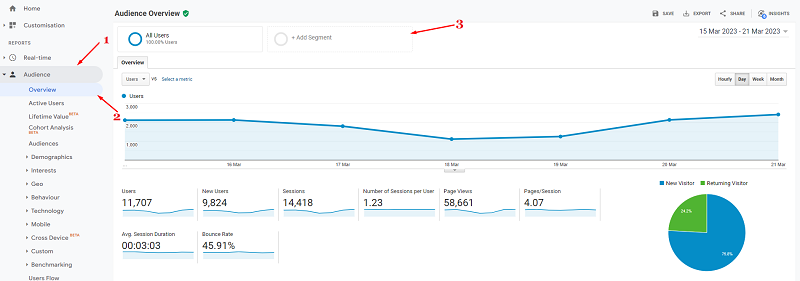 Our plan is to create a segment that doesn’t contain sessions from pages that we count as real direct traffic drivers. Click on “Custom” (1), then “New Segment” (2).
Our plan is to create a segment that doesn’t contain sessions from pages that we count as real direct traffic drivers. Click on “Custom” (1), then “New Segment” (2).
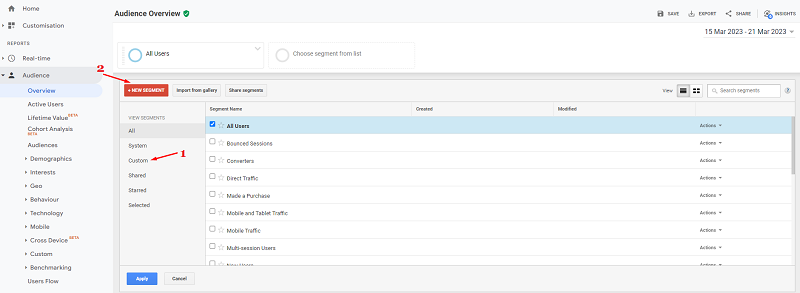 Click “Conditions” (1) and begin to add filters excluding the mostly direct traffic pages. Remember that there aren’t any strict rules to follow here. You can exclude as many pages as you wish, as long as you believe that they are mostly typed in or bookmarked.
Click “Conditions” (1) and begin to add filters excluding the mostly direct traffic pages. Remember that there aren’t any strict rules to follow here. You can exclude as many pages as you wish, as long as you believe that they are mostly typed in or bookmarked.
You may also want to exclude returning visitors with the User Type filter. A person that has your website bookmarked usually revisits your page multiple times, which accounts for direct traffic.
Once you’ve set up all the filters you need, type in the Segment Name and click “Save” (2).
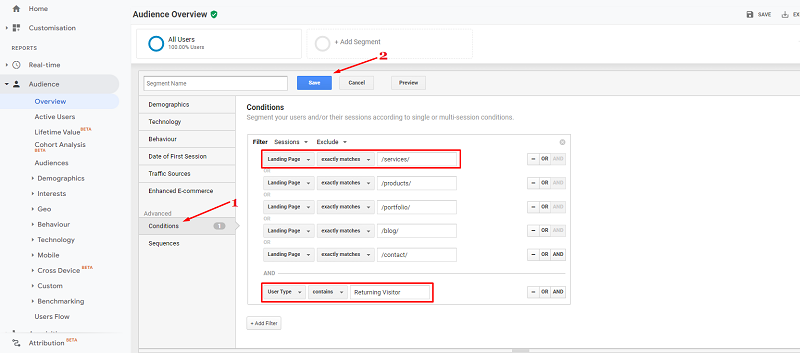 To see the traffic volume filtered out by your segment, from the Homepage, go to “Acquisition” (1), then to “All Traffic” (2), and “Channels” (3). Make sure that you have the correct segment selected (4), and in the “Direct” channel (5) you will see the total number of users estimated to belong to dark social.
To see the traffic volume filtered out by your segment, from the Homepage, go to “Acquisition” (1), then to “All Traffic” (2), and “Channels” (3). Make sure that you have the correct segment selected (4), and in the “Direct” channel (5) you will see the total number of users estimated to belong to dark social.
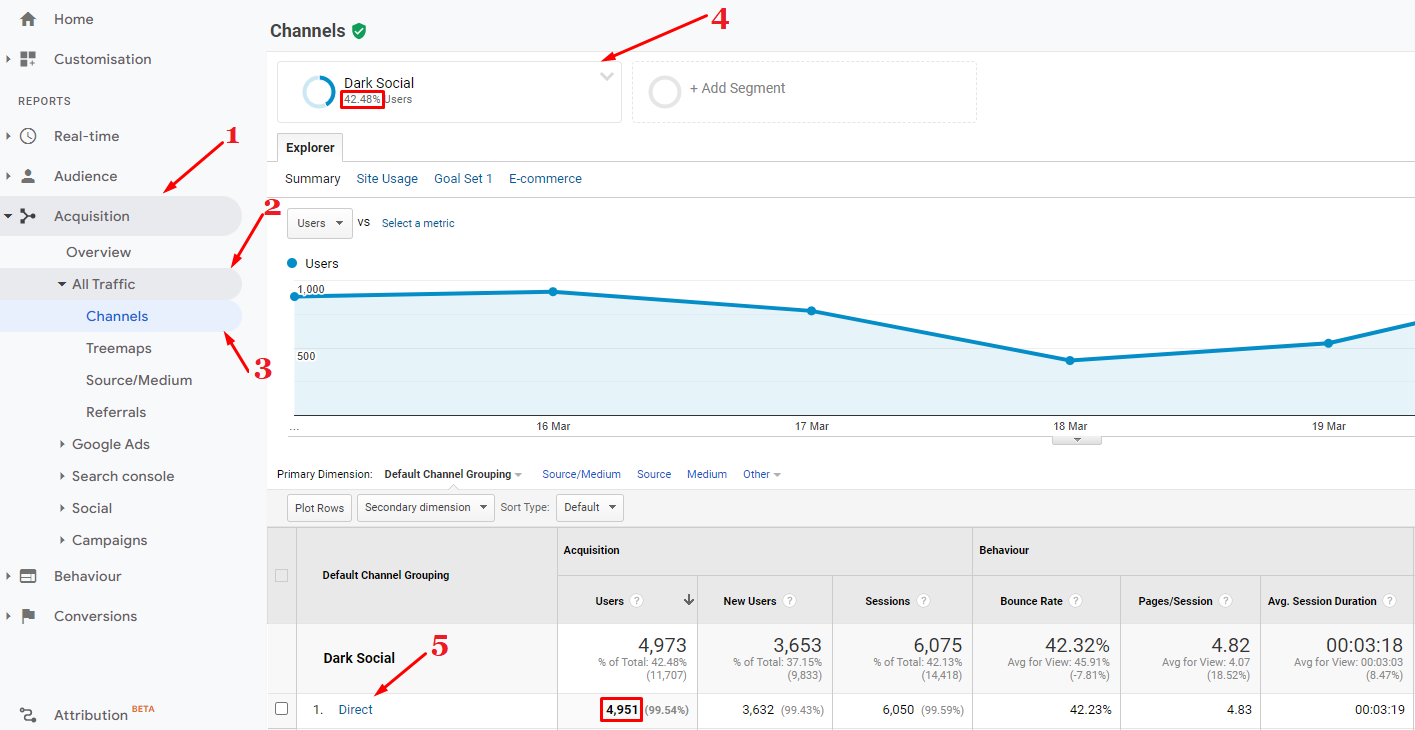 The above process works for Universal Analytics, however, after July 1, 2023 it will no longer gather new data and will be replaced by Google Analytics 4. If your company has already migrated to GA4 or is planning to do it soon, you’ll need to follow a slightly different action plan.
The above process works for Universal Analytics, however, after July 1, 2023 it will no longer gather new data and will be replaced by Google Analytics 4. If your company has already migrated to GA4 or is planning to do it soon, you’ll need to follow a slightly different action plan.
GA4 has no Segment function, so you won’t be able to create a Segment like in the above algorithm. Instead, you will use filters to perform the exact same function – exclude real direct traffic.
To do that, from the Homepage, go to “Reports” (1), then “Acquisition” (2), followed by “User Acquisition” (3), and click on “Add Filter” (4).
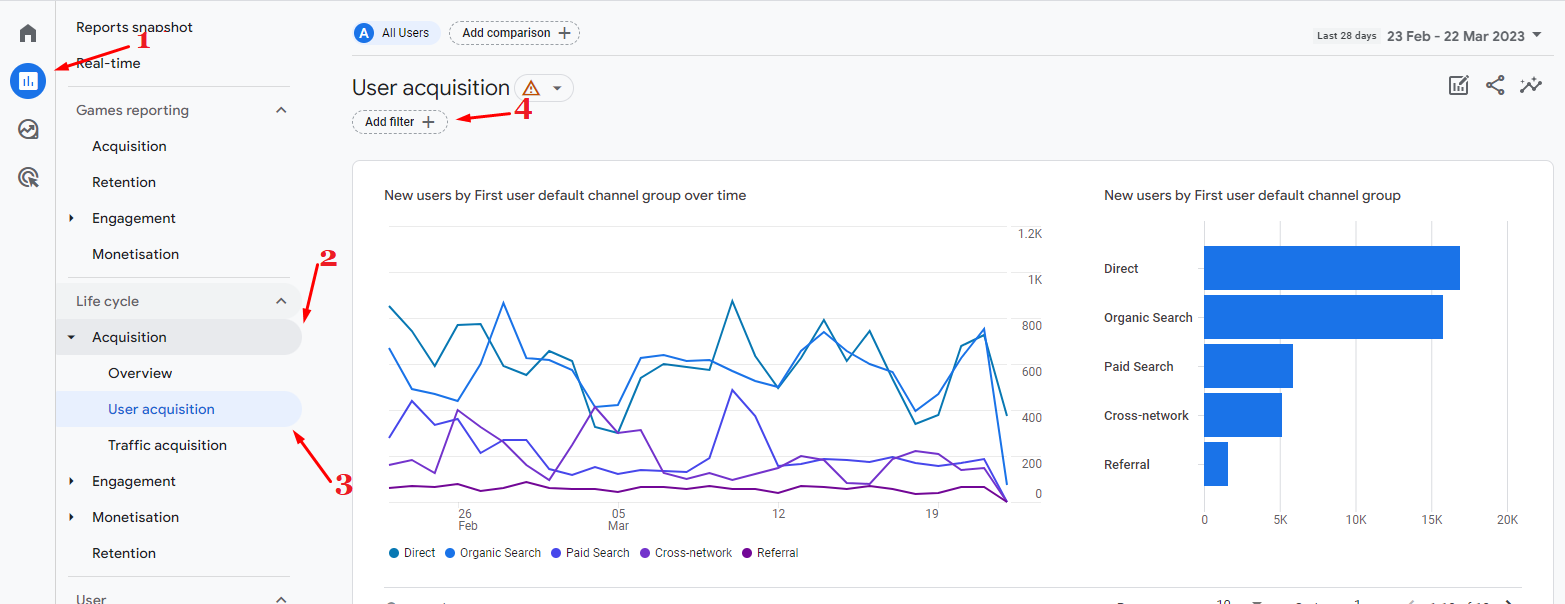 In the pop-up on the right side of your screen, create a filter that excludes the dimension “Landing page + query string”, and check all the pages you’d like to remove (1). Once you’re done, press “OK” (2), and “Apply” (3).
In the pop-up on the right side of your screen, create a filter that excludes the dimension “Landing page + query string”, and check all the pages you’d like to remove (1). Once you’re done, press “OK” (2), and “Apply” (3).
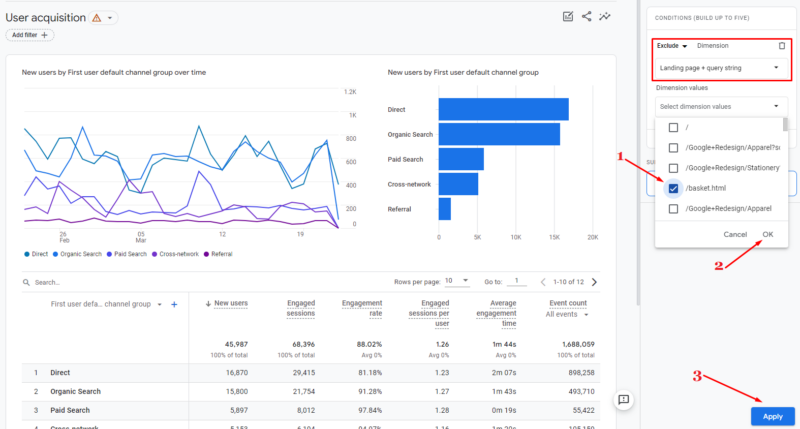 The filter will now exclude the selected pages from the report, and you will be able to see the dark social traffic volume under “Direct”.
The filter will now exclude the selected pages from the report, and you will be able to see the dark social traffic volume under “Direct”.
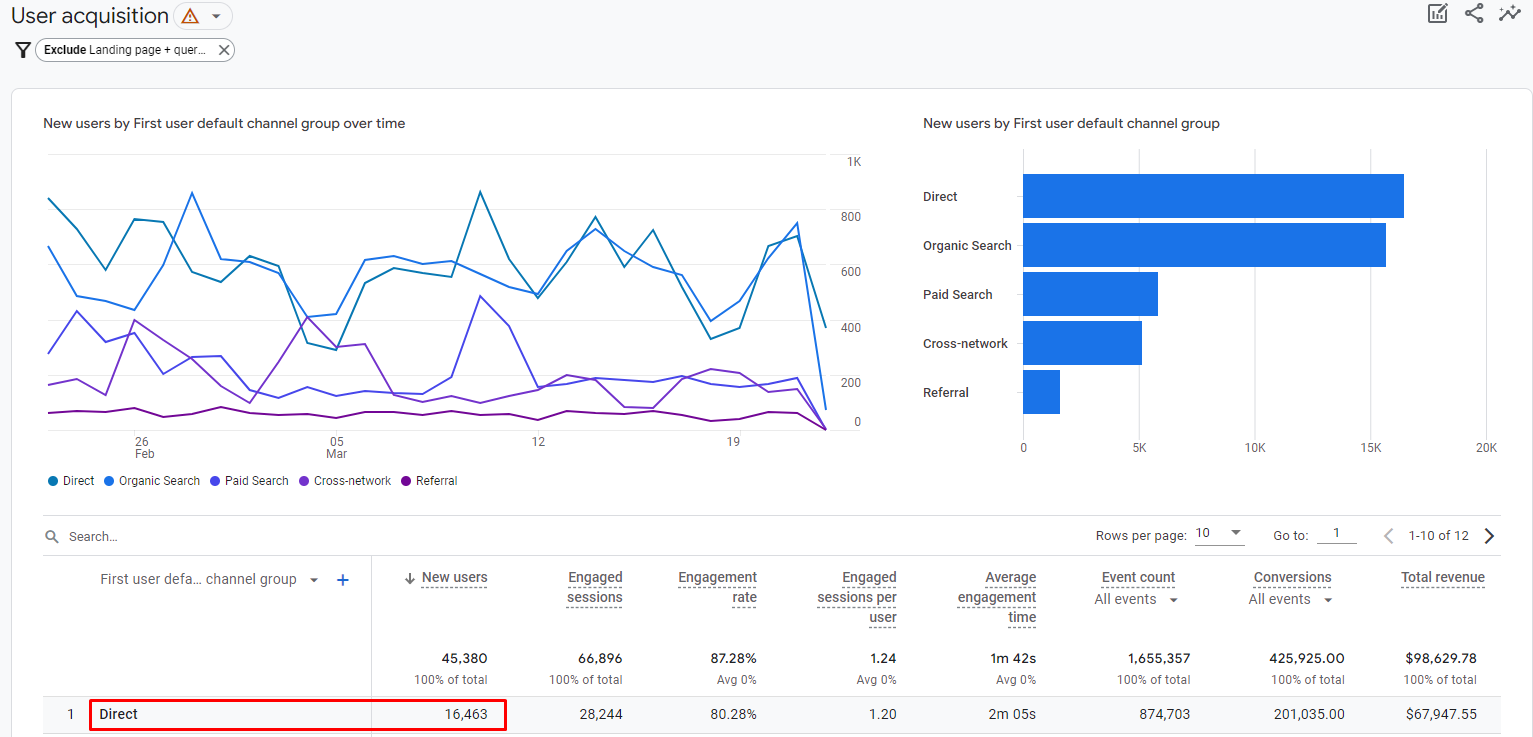 2. Ask The Users Directly
2. Ask The Users Directly
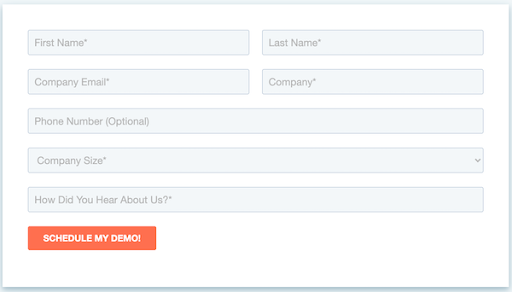 You can find out if a lead came from dark social by simply asking them. Insert an extra field into your contact form that contains a question like “How did you learn about us?”. This way, it will look something like this:
You can find out if a lead came from dark social by simply asking them. Insert an extra field into your contact form that contains a question like “How did you learn about us?”. This way, it will look something like this:
If a lead claims that they heard about your business from a friend or they saw your presentation at an event, they belong to dark social.
Getting precise lead source information at an early stage will also benefit your sales process. Once you know what kind of touchpoints a lead had with your company before contacting you, you can adapt your pitching techniques. If a lead finds out about you by seeing your how-to video on LinkedIn, for instance, you can already deduce potential pain points that the lead suffers from.
3. Try dark social tracking tools
To accurately track dark social, you can use a tool that helps you understand the user’s journey more effectively. These tools combine various sources of information, such as incorporating feedback from users, to map out the user’s journey as accurately as possible. By doing so, you get a reliable revenue attribution modeling platform that can help you track the success of your marketing efforts.
Dreamdata.io, for example, is such a marketing attribution platform. It helps businesses track and measure the impact of their marketing efforts across all channels, including dark social. It can attribute revenue generated from dark social channels to specific marketing touchpoints, provide insights into the customer journey and conversion rates, identify target audiences, and calculate ROI.
Hockeystack is a powerful marketing attribution platform that enables businesses to measure dark social lead generation. It uses a unique tracking code embedded in shared links to capture data on user engagement in dark social channels, providing businesses with valuable insights into their audience’s behavior. Additionally, Hockeystack’s advanced algorithms can attribute revenue to specific marketing touchpoints, allowing businesses to track the effectiveness of their marketing efforts. Hockeystack also offers analytics on audience engagement and behavior, enabling businesses to optimize their marketing strategy for better performance.
Getsocial.io assists businesses in tracking dark social activities through a tracking code that is embedded in shared links, which captures data on user engagement in these channels. The platform attributes revenue to specific marketing touchpoints based on advanced algorithms, providing valuable insights into how dark social activities contribute to revenue generation. Furthermore, it also offers analytics on audience engagement and behavior, which can be used by businesses to optimize their marketing strategy for far better results.
Addthis is a service that enables you to insert special share buttons on your website pages that are coded to track dark social. If a link to your page was shared privately in a messenger with the help of Addthis buttons, your analytics will be able to identify it.
ShareThis is a similar tool to Addthis, allowing you to use share buttons with embedded trackable links. It also has additional unrelated, but useful functionalities such as a privacy policy generator.
Why You Must Track Lead Generation From Dark Social
According to research done by RadiumOne, 69% of all website links are shared privately. And while RadiumOne’s report dates as far back as 2014, it’s reasonable to assume that that number has only grown over the past years. Thus, regardless of your industry, there will be a considerable portion of visitors that your analytics tool recognizes as “direct traffic”, whereas they are actually social-driven traffic.
Being able to estimate that number will help you understand the real reach of your social media campaigns beyond the clicks you get from LinkedIn posts. In turn, understanding your reach is necessary when assessing the efficiency of your social media efforts. Some activities may be deemed inefficient when only looking at numbers from the “Social” channel in Google Analytics. At the same time, sudden rises in the “Direct” channel a lot of marketing specialists may see as luck or something beyond their control, which is not entirely true.
Leads coming from dark social tend to be the ones with the highest conversion rates. That is because they often involve interactions on a personal level, for instance, recommendations given by friends or coworkers. People are more likely to make a purchase if they are influenced by someone they know and trust.
Dark social leads are also often misqualified. Following advice from a friend, a person may have very strong buying intent when coming to your website and filling out a contact form. However, a marketing team will recognize this lead as cold, having registered only one interaction with the website and coming from direct traffic. The sales team then chooses the wrong approach when talking to the lead and risks losing them altogether.

 Our plan is to create a segment that doesn’t contain sessions from pages that we count as real direct traffic drivers. Click on “Custom” (1), then “New Segment” (2).
Our plan is to create a segment that doesn’t contain sessions from pages that we count as real direct traffic drivers. Click on “Custom” (1), then “New Segment” (2). Click “Conditions” (1) and begin to add filters excluding the mostly direct traffic pages. Remember that there aren’t any strict rules to follow here. You can exclude as many pages as you wish, as long as you believe that they are mostly typed in or bookmarked.
Click “Conditions” (1) and begin to add filters excluding the mostly direct traffic pages. Remember that there aren’t any strict rules to follow here. You can exclude as many pages as you wish, as long as you believe that they are mostly typed in or bookmarked.  To see the traffic volume filtered out by your segment, from the Homepage, go to “Acquisition” (1), then to “All Traffic” (2), and “Channels” (3). Make sure that you have the correct segment selected (4), and in the “Direct” channel (5) you will see the total number of users estimated to belong to dark social.
To see the traffic volume filtered out by your segment, from the Homepage, go to “Acquisition” (1), then to “All Traffic” (2), and “Channels” (3). Make sure that you have the correct segment selected (4), and in the “Direct” channel (5) you will see the total number of users estimated to belong to dark social.  The above process works for Universal Analytics, however, after July 1, 2023 it will no longer gather new data and will be replaced by Google Analytics 4. If your company has already migrated to GA4 or is planning to do it soon, you’ll need to follow a slightly different action plan.
The above process works for Universal Analytics, however, after July 1, 2023 it will no longer gather new data and will be replaced by Google Analytics 4. If your company has already migrated to GA4 or is planning to do it soon, you’ll need to follow a slightly different action plan.  In the pop-up on the right side of your screen, create a filter that excludes the dimension “Landing page + query string”, and check all the pages you’d like to remove (1). Once you’re done, press “OK” (2), and “Apply” (3).
In the pop-up on the right side of your screen, create a filter that excludes the dimension “Landing page + query string”, and check all the pages you’d like to remove (1). Once you’re done, press “OK” (2), and “Apply” (3). The filter will now exclude the selected pages from the report, and you will be able to see the dark social traffic volume under “Direct”.
The filter will now exclude the selected pages from the report, and you will be able to see the dark social traffic volume under “Direct”. 2. Ask The Users Directly
2. Ask The Users Directly You can find out if a lead came from dark social by simply asking them. Insert an extra field into your contact form that contains a question like “How did you learn about us?”. This way, it will look something like this:
You can find out if a lead came from dark social by simply asking them. Insert an extra field into your contact form that contains a question like “How did you learn about us?”. This way, it will look something like this: 